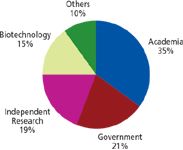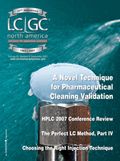Single-Cell Whole Genome Amplification PCR
Single-cell PCR is an application of PCR technology, which deals with the nucleic acid in single cells rather than in a tissue sample or a pool of homogenous cells. While single-cell amplification has been recognized almost as long as the PCR technology itself, it was not considered a very efficient technique due to uncontrollable circumstances such as the lack of available primers and efficient cell-lysing techniques, which only allowed a small quantity of cell DNA to be amplified.
Single-cell PCR is an application of PCR technology, which deals with the nucleic acid in single cells rather than in a tissue sample or a pool of homogenous cells. While single-cell amplification has been recognized almost as long as the PCR technology itself, it was not considered a very efficient technique due to uncontrollable circumstances such as the lack of available primers and efficient cell-lysing techniques, which only allowed a small quantity of cell DNA to be amplified. However, advances in primer technologies and lysing techniques allowed scientists to amplify the whole cell genome. The technique is known as single-cell whole genome amplification (WGA).

2006 Industrial Distribution of Whole Genome Amplification
Isolation is the first step in single-cell WGA and can be accomplished by numerous established cell-sorting methods, including flow cytometry. The two most widely used WGA methods are primer extension PCR (PEP) and degenerative oligonucleotide primer (DOP). PEP was one of the first WGA methods developed and uses a high number of PCR cycles at low temperatures. However, even though a large portion of the genome is capable of being probed and amplified by this method, some segments of the DNA, especially those with a repeating nature, tend to be left out. DOP is a more established technique. As its name suggests, it uses degenerative oligonucleotide primers and Taq polymerases to bind at low temperatures, followed by cycles with high annealing temperatures.
There is a wide variety of applications for single cell WGA, ranging from drug discovery to cancer research to diagnostics. Prenatal research and diagnostic screening applications are expected to be the initial target for this technology.
The overall PCR market is expected to post low double-digit growth over the next five years fueled by molecular diagnostics and innovative technologies like WGA. In addition, many contract/independent research organizations, along with the kit manufacturers, have started to provide WGA services, whose customers include industries such as academia, pharmaceuticals, biotech, government, and clinical/hospital laboratories, among others.
The foregoing data was extracted and adapted from SDi's Market Analysis and Perspective Report entitled Genomic/Nucleic Acid Analysis, which covers research, applied and molecular diagnostic markets. For more information, contact Glenn Cudiamat, VP of Research Services, Strategic Directions International, Inc., 6242 Westchester Parkway, Suite 100, Los Angeles, CA 90045, tel. (310) 641-4982, fax: (310) 641-8851, e-mail: cudiamat@strategic-directions.com
Study Explores Thin-Film Extraction of Biogenic Amines via HPLC-MS/MS
March 27th 2025Scientists from Tabriz University and the University of Tabriz explored cellulose acetate-UiO-66-COOH as an affordable coating sorbent for thin film extraction of biogenic amines from cheese and alcohol-free beverages using HPLC-MS/MS.
Quantifying Microplastics in Meconium Samples Using Pyrolysis–GC-MS
March 26th 2025Using pyrolysis-gas chromatography and mass spectrometry, scientists from Fudan University and the Putuo District Center for Disease Control and Prevention detected and quantified microplastics in newborn stool samples.










